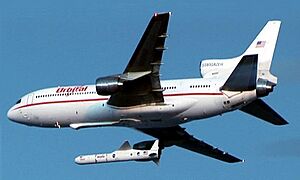Air-launch-to-orbit facts for kids

Air launch to orbit is a special way to send rockets into space. Instead of launching from the ground, a large airplane carries the rocket high up into the sky. When the plane reaches a certain height, it releases the rocket. The rocket then fires its engines and flies the rest of the way to space, carrying satellites or other important cargo into low Earth orbit. This method can offer some cool advantages over traditional ground launches.
Contents
Air Launch to Orbit
How Does Air Launch Work?
Air launch systems use a large aircraft, often a modified passenger or cargo plane, to carry a rocket. The rocket is usually attached under the plane's wing or belly. The plane takes off from a regular runway, just like any other aircraft. It then flies to a specific altitude and location, which is usually very high up in the atmosphere.
Once the plane reaches the right spot, it releases the rocket. The rocket then ignites its own engines. Because it's already high in the sky and moving fast, it saves a lot of fuel compared to launching from the ground. This makes the journey to space more efficient.
Why Use Air Launch?
There are several good reasons why scientists and engineers use air launch:
- Flexibility: Airplanes can take off from many different airports. This means they are not tied to a single launch pad. They can also fly around bad weather, like storms, to find a clear launch window.
- Efficiency: Launching from high in the atmosphere means the rocket doesn't have to push through as much thick air. This saves fuel and allows the rocket to carry more weight into space.
- Cost Savings: Building and maintaining a ground launch pad can be very expensive. Air launch uses existing airport infrastructure, which can help reduce overall costs.
- Speed: Sometimes, air launch systems can be prepared and launched more quickly than traditional rockets. This is useful for urgent missions.
Famous Air Launch Systems
Over the years, several companies have developed or used air launch systems.
Pegasus Rocket
One of the most well-known air launch systems is the Pegasus rocket. It was developed by Orbital Sciences Corporation (now part of Northrop Grumman). The Pegasus rocket is usually carried by a modified Lockheed L-1011 TriStar jet, nicknamed Stargazer.
The Stargazer flies to about 39,000 feet (12,000 meters) over the ocean. It then drops the Pegasus rocket. A few seconds later, the rocket's first stage engine fires, sending it towards space. Pegasus has successfully launched many small satellites into orbit since its first flight in 1990.
Virgin Orbit
Virgin Orbit was another company that used an air launch system. Their system was called LauncherOne. It used a modified Boeing 747 jumbo jet, named Cosmic Girl, to carry the rocket. The idea was similar to Pegasus: fly high, drop the rocket, and then launch it into orbit. Virgin Orbit aimed to provide flexible and dedicated launches for small satellites.
The Future of Air Launch
Air launch technology continues to be explored. It offers a unique way to access space, especially for smaller satellites that don't need giant rockets. As more and more satellites are launched for things like internet access and Earth observation, air launch could become even more important. It provides another option for getting our technology into orbit.

